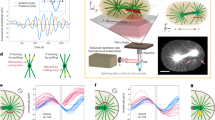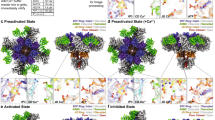Abstract
We have combined a rapid cytoplasmic sampling technique with capillary electrophoresis to measure the activation of protein kinase C (PKC) in a small region (approximately 60 μm) of a Xenopus oocyte. The phosphorylation of a fluorescent PKC substrate was measured following addition of a pharmacological or physiological stimulus to an oocyte. When substrates for cdc2 kinase (cdc2K), PKC, and protein kinase A (PKA) were comicroinjected into an oocyte, all three substrates could be identified on the electropherogram after cytoplasmic sampling. With this new method, it should be possible to measure simultaneously the activation of multiple different kinases in a single cell, enabling the quantitative dissection of signal transduction pathways.
This is a preview of subscription content, access via your institution
Access options
Subscribe to this journal
Receive 12 print issues and online access
$209.00 per year
only $17.42 per issue
Buy this article
- Purchase on Springer Link
- Instant access to full article PDF
Prices may be subject to local taxes which are calculated during checkout






Similar content being viewed by others
References
Brooker, G., Seki, T., Croll, D. & Wahlestedt, C. Cacium wave evoked by activation of endogenous or exogenously expressed receptors in Xenopus oocyte. Proc. Natl. Acad. Sci. USA 87, 2813–2817 (1990).
Kline, D. et al. Fertilization events induced by neurotransmitters after injection of mRNA in Xenopus eggs. Science 241, 464– 467 (1988).
Zagotta, W.N., Hoshi, T. & Aldrich, R.W. Gating of single Shaker potassium channels in Drosophila muscle and in Xenopus oocytes injected with Shaker mRNA. Proc. Natl. Acad. Sci. USA 86, 7243– 7247 (1989).
Lechleiter, J., Girard, S., Clapham, D. & Peralta, S. Subcellular patterns of calcium release determined by G protein-specific residues of muscarinin receptors. Nature 350, 505– 508 (1991).
Luzzi, V., Lee, C.-L. & Allbritton, N.L. Localized sampling of cytoplasm from Xenopus oocytes. Anal. Chem. 23, 4761– 4767 (1997).
Hausen, P. & Riebesell, M. in The early development of Xenopus laevis (Springer-Verlag, New York; 1991).
Tigyi, G., Dyer, D., Matute, C. & Miledi, R A serum factor that activates the phosphatidyinositol phosphate signaling system in Xenopus oocytes. Proc. Natl. Acad. Sci. USA 87, 1521–1525 (1990).
Tigyi, G. & Miledi, R. Lysophosphatidates bound to serum albumin activate membrane currents in Xenopus oocytes and neurite retraction in PC12 pheochromocytoma cells. J. Biol. Chem. 267, 21360–21367 (1992).
Guo, Z. et al. Molecular cloning of a high-affinity receptor for the growth factor-like lipid mediator lysophosphatidic acid from Xenopus oocyte. Proc. Natl. Acad. Sci. USA 93, 14367–14372 (1996).
Pongracz, J., Clark, P., Neoptolemos, J.P. & Lord, J.M. Expression of protein kinase C isoenzymes in colorectal cancer tissue and their differential activation by different bile acids. Int. J. Cancer 61, 35–39 ( 1995).
Smith, M.K., Colbran, R.J. & Soderling, T.R. Specificities of autoinhibitory domain peptides for four protein kinases. J. Biol. Chem. 265, 1837–1840 (1990).
House, C. & Kemp, B.E. Protein kinase C contains a pseudosubstrate prototype in its regulatory domain. Science 238, 1726–1728 (1987).
Srinivasan, J., Koszelak, M., Mendelow, M., Kwon, Y.G. & Lawrence, D.S. The design of peptide-based substrates for the cdc2 protein kinase. Biochem. J. 309, 927–931 (1995).
Colbran, J.L. et al. cAMP-dependent protein kinase, but not the cGMP-dependent enzyme, rapidly phosphorylates delta-CREB, and a synthetic delta-CREB peptide. Biochem. Cell Biol. 70, 1277–1282 (1992).
Tsien, R. & Pozzan, T. Measurement of cytosolic Ca2+ with quin2. Methods. Enzymol. 172, 230–262 (1989).
Tigyi, G. et al. Lysophosphatidic acid-induced neurite retraction in PC12 cells: neurite-protective effects of cyclic AMP signaling. J. Neurochem. 66, 549–558 (1996).
Tigyi, G. et al. Lysophosphatidic acid-induced neurite retraction in PC12 cells: control by phosphoinositide-Ca2+ signaling and Rho. J. Neurochem. 66, 537–548 ( 1996).
Erim, F.B., Cifuentes, A., Poppe, H. & Kraak, J.C. Performance of a physically adsorbed high-molecular-mass polyethyleneimine layer as coating for the separation of basic proteins and peptides by capillary electrophoresis. J. Chromatogr. A 708, 356– 361 (1995).
Weinberger, R. in Practical capillary electrophoresis (Academic Press, San Diego, 1993).
Acknowledgements
The authors are grateful to Jay Boniface and Augie Sanchez for advice on purification and fluorescent labeling of peptide, and to Hong Ngoc Dao, Cuong Vu, and Veronica Luzzi for technical assistance. The authors also thank Lee Moritz, Richard Busby, and Ron Hulme for fabrication of devices and for helpful discussions on equipment design. This work was supported by the Arnold and Mabel Beckman Foundation, the Searle Scholars Program, and the National Institutes of Health (GM57015 and RR13314 to N.L.A., K08AI01513 to C.E.S.). C.-L.L. was supported by a fellowship from the National Defense Medical Center, Taiwan R.O.C.
Author information
Authors and Affiliations
Corresponding author
Rights and permissions
About this article
Cite this article
Lee, CL., Linton, J., Soughayer, J. et al. Localized measurement of kinase activation in oocytes of Xenopus laevis . Nat Biotechnol 17, 759–762 (1999). https://doi.org/10.1038/11691
Received:
Accepted:
Issue Date:
DOI: https://doi.org/10.1038/11691
This article is cited by
-
Interspecies comparison of peptide substrate reporter metabolism using compartment-based modeling
Analytical and Bioanalytical Chemistry (2017)
-
Measurement of kinase activation in single mammalian cells
Nature Biotechnology (2000)
-
A fluorescent indicator for visualizing cAMP-induced phosphorylation in vivo
Nature Biotechnology (2000)
-
Are you active in there, kinase?
Nature Biotechnology (1999)



